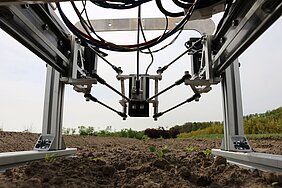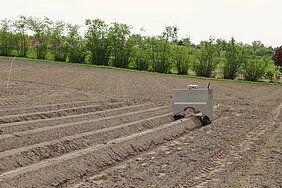Hours of hoeing, row after row – that is the reality of weed control in organic vegetable farming. The young plants compete for light, water and nutrients, and without herbicides, the only option is manual labour. On large areas, this quickly becomes an exhausting and extremely costly task. With JaetRobi, manual weeding in vegetable fields could soon be a thing of the past.
Researchers at Leibniz Institute for Agricultural Engineering and bioeconomy in Potsdam (ATB) have developed a solution for this. Karuna Koch is a scientist at ATB and an expert in computer vision and machine learning. She explains: “Imagine an attachment for tractors or a small field robot equipped with a camera. As it travels over the vegetable ridge, the camera takes pictures that are analysed in real time by an integrated computer using AI. It then decides which plants should be removed and controls a high-precision tool. In the JaetRobi project, we have developed a module that automatically detects weeds in this way and removes them with millimetre precision using a laser.”
The starting point for the project was a specific practical challenge: the company Naiture wanted to increase the service life of its automated hoeing tools, which were already available on the market. Working closely together, the project partners therefore pursued and compared two technological approaches: While part of the consortium further developed the existing mechanical solution, ATB, together with the Technical University of Berlin, worked out a fundamentally new alternative based on a blue laser.
Cutting, burning or hoeing?
The new laser module automatically targets young weeds and damages them in what is known as the growth centre. Blue diode lasers are used, whose light is absorbed particularly strongly by plant tissue. While infrared lasers, some of which are already in use, often lose their energy in water droplets and must first heat or evaporate moisture, blue laser light penetrates directly into the tissue. This means that less power is required and the effect is like a precise cut. Large-scale burning is avoided and the risk of heat damage to crops is reduced. The new laser can work very close to the crop, but has to target the weeds one after the other. The mechanical module, on the other hand, uses twelve micro-hoes simultaneously, achieves a significantly higher area output, but has to maintain a greater minimum distance from the crop. In its current state of development, the laser module is particularly suitable for stop-and-go operation in combination with field robots, while the mechanical module is also designed for continuous use on tractors.
Accurate to the millimetre
Karuna Koch and the team at ATB and TU Berlin are developing software and hardware for the laser module, including weed detection: "Our application scenario focuses on weeds from the cotyledon stage to the appearance of the first true leaves. Our trials are currently running with plants up to two centimetres in size. In order to be able to distinguish them precisely from carrots, for example, during the passage, we first created an image database and annotated weeds and crops. This enabled us to train an AI that can now distinguish weeds from carrots with 94% accuracy, starting from the cotyledon stage. In the next step, our engineers constructed a positioning unit that moves the laser over the weeds with millimetre precision and activates it at the right time for the optimal duration," reports Koch.
An opportunity for biodiversity
In the next step, the researchers plan to further expand the system, which is currently running as a functional prototype. "We want to make the system even more robust. Since the laser takes longer in areas with more weeds, this currently requires a dynamic speed. The varying heights of the plants in the dams also pose a challenge. Nevertheless, we believe this technology has great potential. It could make work much easier and promote biodiversity at the same time. In future, we only want to remove “weeds” that actually affect the crops. Our algorithm can leave the rest alone, which would actually speed up the work," Koch is convinced.
Once the project is complete, the researchers will publish the image database and the trained AI for scientific and industrial purposes. The main goal of ATB's work until then will be to further develop the module so that it can be adopted by industry.
The user perspective
To this end, ATB organised a user workshop with live demonstrations at Fieldlab for Digital Agriculture. The exchange with practitioners and industry revealed the particular importance of reliability and service. In contrast, smaller farms seemed more willing to use unconventional systems, such as small field robots with integrated control modules. Large farms value conventional solutions that can work in multiple rows as attachments.
More information about the project.
Background
The project is funded by the Federal Ministry of Agriculture, Food and Regional Identity (BMLEH) as part of the Digitalisation in Agriculture programme and will run in its first phase until December 2025. Partners include the Technical University of Berlin, the Technical University of Dresden, and industry partners Hydrive Engineering GmbH and Technische Werkstätten Langengrassau GmbH.
Contact
Karuna Koch
Scientist for Automation and Field Robotics at ATB
Email: KKoch@atb-potsdam.de
Jessica Lietze
Officer for Press and public relations at ATB
Tel.: +49 331 5699-819
Email: presse@atb-potsdam.de


